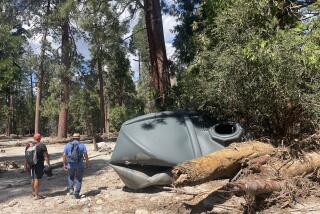Remembering ‘Enemy’ Orphans
Fifty-fine years after it was created in the California desert by the U.S. Army, Manzanar remains a spare place of heartbreak and hope set against a magnificent backdrop of High Sierra peaks.
An especially poignant footnote to Manzanar’s legacy was related in The Times by staff writer Renee Tawa. It is the story of the 101 Japanese American orphans, mostly from Southern California, who were interned at the relocation camp during World War II. The story of the camp itself is well known, although Americans need to keep reminding themselves of the significance of this bleak place in the Owens Valley.
Ringed by barbed wire and machine gun towers, Manzanar was the home to an estimated 10,000 Japanese Americans, most of them U.S. citizens, for four harsh summers and four bitter winters. The Manzanar residents and thousands of others at nine similar camps were evacuated from the West Coast and interned for fear they would commit warlike acts in behalf of Japan.
Most were families who put together a bare semblance of home life in cramped wooden barracks. In time, many older boys joined the Army and fought with distinction in Europe.
Now the story of Manzanar’s Children’s Village is being compiled as a research project at Cal State Fullerton. And there is some incentive to complete the research soon for the former population of the wartime camp is dwindling. As time passes, more stories are left untold.
Meanwhile, the National Park Service is developing plans for a memorial at Manzanar, which Congress designated as a national historic site five years ago. The National Park Service has acquired the 800-acre site along U.S. 395 from its owner, the Los Angeles Department of Water and Power. But it may be another 10 years before a visitors center can be built because of a lack of Park Service funds.
The idea of a memorial remains controversial in Inyo County, where some residents insist a it would represent a concession to Japanese aggression and an apology for a legitimate governmental act. They don’t understand.
With or without a building or monument, Manzanar is a reminder of the frailties of constitutional government in the face of panic, anger and racial intolerance. Manzanar is a memorial to the human spirit of those who remained steadfastly loyal to the country that imprisoned them.
But the true innocents of Manzanar were those 101 orphans, confined to three tarpaper-covered barracks with no families for support. “It was the end of the world for me,” one boy said years later.
Appropriately, the Park Service will remember the orphans first with a marker at the site of Children’s Village later this year.
More to Read
Sign up for Essential California
The most important California stories and recommendations in your inbox every morning.
You may occasionally receive promotional content from the Los Angeles Times.










